Risk Factors Analysis of Diaper Dermatitis in Children Aged 0-36 Months at Puskesmas Working Area, Tembalang District
Keywords:
Risk factors; Diaper dermatitis; Personal hygieneAbstract
Diaper dermatitis is an inflammation of the skin in the diaper area caused by contact with urine and feces and the friction of the diaper against the skin. The incidence of diaper dermatitis in Indonesia is 7-35% in male and female infants with the highest number at the age of 6-12 months. The purpose of this study was to determine the factors associated with diaper dermatitis in children aged 0-36 months at the Tembalang District Puskesmas, such as age, gender, mother's education level, mother's occupation, economic status, frequency of diaper changes, and personal hygiene. This study used an observational analytic method of Case-Control approach with a sample of 30 people, 15 case groups and 15 control groups with purposive sampling technique. Data were obtained through a questionnaire instrument which was then tested with the Chi-Square test with the help of software. Statistical test results showed no significant relationship between age, gender, mother's education level, mother's occupation, and economic status with the occurrence of diaper dermatitis and there was a significant relationship between the frequency of diaper changes 0.013 (p < 0.05) and personal hygiene 0.008 (p < 0.05). There is a significant relationship between the frequency of diaper changes and personal hygiene with the occurrence of diaper dermatitis, and there is no significant relationship with other risk factors.
References
Price AD, Lythgoe J, Ackers-Johnson J, Cook PA, Clarke-Cornwell AM, MacVane Phipps F. The
BaSICS (Baby Skin Integrity Comparison Survey) study: A prospective experimental study
using maternal observations to report the effect of baby wipes on the incidence of irritant
diaper dermatitis in infants, from birth to eight weeks of age. Pediatr Neonatol.
;doi:10.1016/j.pedneo.2020.10.003
Yusriani E. Gambaran Pengetahuan Ibu Tentang Ruam Popok pada Bayi 0-12 Bulan di
Klinik Bersalin Hadijah Tahun 2017. 2018;2(3).
Lestari I. Hubungan Tingkat Pengetahuan Ibu dengan Kejadian Ruam Popok pada Bayi 0-
Bulan di Puskesmas Bogor Barat. 2017:27-31.
Lita N. Gambaran Pemakaian Diapers Sekali Pakai pada Anak Usia Prasekolah. Photon.
;7(2):47-52.
Carr AN, DeWitt T, Cork MJ, et al. Diaper dermatitis prevalence and severity: Global
perspective on the impact of caregiver behavior. Pediatr Dermatol. 2020;37(1):130-136.
doi:10.1111/pde.14047
Ullya, Widyawati, Armalina D. Hubungan Antara Pengetahuan dan Perilaku Ibu dalam
Pemakaian Disposable Diapers pada Batita dengan Kejadian Ruam Popok. Diponegoro Med
J (Jurnal Kedokt Diponegoro). 2018;7(2):485-498.
Li C, Zhu Z, Dai Y. Diaper Dermatitis: a Survey of Risk Factors for Children Aged 1 – 24
Months in China. J Int Med Res. 2012;40(1):1752-1760.
doi:10.1177/030006051204000514
Susanti H, Hastuti P. Hubungan Personal Hygiene dengan Kejadian Diaper Rush pada Balita
di Desa Randuagung Kecam Atan Sumber Kabupaten Rembang. J Ilmu Kebidanan dan
Kesehat. 2016;7(1):7-10.
Naimah A. Hubungan Pemakaian Popok Sekali Pakai pada Balita (Usia 0–3 Tahun) dengan
Terjadinya Dermatitis Alergi Popok di Purwoharjo Banyuwangi. Indones J Heal Sci.
;11(2):167. doi:10.32528/ijhs.v11i2.2959
Yuriati P, Noviandani R. Hubungan Pengetahuan Orang Tua dan Tindakan Pencegahan
dengan Kejadian Diaper Rush (Ruam Popok) di Wilayah Kerja Puskesmas Mekar Baru
Tahun 2017. J Cakrawala Kesehat. 2017;VIII(01):39-47.
Rustiyaningsih A, Rustina Y, Nuraini T. Faktor yang Berhubungan dengan Ruam Popok pada
Bayi Baru Lahir. J Persat Perawat Nas Indones. 2018;3(2):58. doi:10.32419/jppni.v3i2.103
Royda D. Hubungan Personal Hygiene dengan Kejadian Diaper Rash pada Bayi di Desa
Ngelele Kecamatan Sumobito Kabupaten Jombang. Stikes Insa Cendekia Med. 2017.
Downloads
Published
How to Cite
Issue
Section
License
Copyright (c) 2023 Ika Dyah Kurniati, Laila Arina Hukma Adila, Retno Indrastiti

This work is licensed under a Creative Commons Attribution-ShareAlike 4.0 International License.
License and Copyright Agreement
In submitting the manuscript to the journal, the authors certify that:
- They are authorized by their co-authors to enter into these arrangements.
- The work described has not been formally published before, except in the form of an abstract or as part of a published lecture, review, thesis, or overlay journal. Please also carefully read Ahmad Dahlan Medical Journal posting Your Article Policy.
- That it is not under consideration for publication elsewhere.
- That its publication has been approved by all the author(s) and by the responsible authorities - tacitly or explicitly - of the institutes where the work has been carried out.
- They secure the right to reproduce any material that has already been published or copyrighted elsewhere.
- They agree to the following license and copyright agreement.
Copyright
Authors who publish with Ahmad Dahlan Medical Journal agree to the following terms:
- Authors retain copyright and grant the journal right of first publication with the work simultaneously licensed under a Creative Commons Attribution License (CC BY-SA 4.0) that allows others to share the work with an acknowledgment of the work's authorship and initial publication in this journal.
- Authors are able to enter into separate, additional contractual arrangements for the non-exclusive distribution of the journal's published version of the work (e.g., post it to an institutional repository or publish it in a book), with an acknowledgment of its initial publication in this journal.
- Authors are permitted and encouraged to post their work online (e.g., in institutional repositories or on their website) prior to and during the submission process, as it can lead to productive exchanges, as well as earlier and greater citation of published work.


